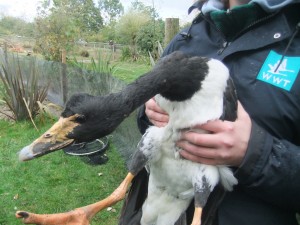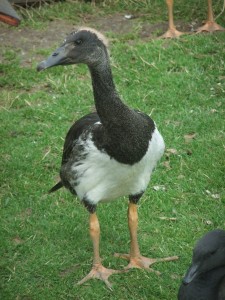Magpie goose success!
 In spring 2012, it was noticed during a routine census that WWT Slimbridge only had 3 Magpie goose males in the grounds, one of which was pushing his mid twenties.
In spring 2012, it was noticed during a routine census that WWT Slimbridge only had 3 Magpie goose males in the grounds, one of which was pushing his mid twenties.
Magpie geese have a wonderfully inovative and remarkable social system based on self protection from predators. A strong hormonal male will gain the favour of a group of females ranging from 1-6 in number. It is his job to vigorously protect them from other Magpies geeese and predators, and to provide for his extended family as best he can. In return the females take it in turns to breed throughout the season, allowing the other females to protect each other's goslings; thus spreading the responsibility. These social birds all take it in turn to incubate, and in captivity will all lay in one communal nest which the male will defend doggedly and devotedly.
 These factors need to be considered most important when stocking magpie geese for exhibition. Although we have upwards of 25 Maggies, they are all either part of one of the three big factions (if you like,) or are still single or unattached to any of these. We can get away with single unattached birds in captivity as there is no threat of predators and the trials and tribulations of finding food are so few that birds never normally come to blows. These issues have a knock on effect with breeding, because if the sex ratio of the hatched sibling group is male high, there will be juvenile males that are side-lined and persecuted. Put on top of that, male Magpie geese take between 6 and 8 years to be fully sexually mature, and this proves that there id a distinct need for holding areas for spare groups.
These factors need to be considered most important when stocking magpie geese for exhibition. Although we have upwards of 25 Maggies, they are all either part of one of the three big factions (if you like,) or are still single or unattached to any of these. We can get away with single unattached birds in captivity as there is no threat of predators and the trials and tribulations of finding food are so few that birds never normally come to blows. These issues have a knock on effect with breeding, because if the sex ratio of the hatched sibling group is male high, there will be juvenile males that are side-lined and persecuted. Put on top of that, male Magpie geese take between 6 and 8 years to be fully sexually mature, and this proves that there id a distinct need for holding areas for spare groups.
 This year we took the plunge and decided to hand rear a clutch. The first clutch were all female; just typical.
This year we took the plunge and decided to hand rear a clutch. The first clutch were all female; just typical.
The second clutch of 5 contained 2 males, 1 of which became a runt.
We decided on a third clutch so as not to be putting all our eggs in one basket. Lo and behold; finally 3 males!
Due to their extended juvenile period these birds will be able to coexist together as brothers and sisters for many years yet. We will mix up the genetics so as to create a group, and observe early signs of dominance to work out the best combinations. These signs will manifest themselves as hormonal lumps that rise up from their foreheads. The two juveniles pictured clearly have totally flat scalps, but the adult female above has a nice hint of one. These lumps are reactionary to the importance of each bird within the group. The male will have the biggest, ranging from between 1cm and 4cm in height. The females develop ones in a stepped order of their favour and dominance.
We are all really chuffed to have bred such a nice brood, and feel calmer now that their breeding future seems more stable. Now it's time to knuckle down to their behavioural observations and maintenance, because as sturdy as they are, they are still quite delicate.

